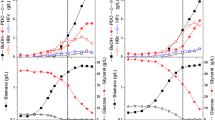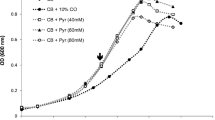Abstract
Clostridium thermosuccinogenes are the only known anaerobic thermophilic bacteria that ferment inulin to succinate and acetate as major products and formate, lactate, and ethanol as minor products. In this study, organic acid production in 2-L fermentations having an initially low (−300 to −330 mV) or high (−220 to −250 mV) redox potential was compared for two strains of C. thermosuccinogenes (DSM 5808 and DSM 5809). Although DSM 5809 consistently provided higher succinate yield, high variability in results was attributed to the absence of redox control during the fermentations, and, therefore, fermentations at three controlled redox potentials (−240, −275, and −310 mV) were conducted. At an intermediate redox potential (−275 mV), the succinate yield was the greatest (0.36 g of succinate/g of hexose unit), whereas ethanol yield was the least (0.02 g/g). Redox potential did not significantly affect acetate or lactate formation. At controlled redox potential of −275 mV, the growth of DSM 5809 on three substrates was also compared: inulin, fructose, and glucose. DSM 5809 had similar growth rates when inulin (0.20/h) or glucose (0.21/h) was the carbon source but grew more slowly when fructose (0.16/h) was the carbon source. Also, the specific rate of utilization of fructose by DSM 5809 was higher (0.89 g of fructose/[g of biomass·h]) compared to glucose (0.53 g/[g·h]) or inulin (0.55 g/[g·h]). Succinate was the major product formed by DSM 5809 fermenting inulin (0.50 g/[g·h]) or glucose (0.36 g/[g·h]), and ethanol was the principal product when DSM 5809 fermented fructose (0.54 g/[g·h]).
Similar content being viewed by others
References
Guiraud, J. and Galzy, P. (1990), in Yeast: Biotechnology and Biocatalysis, Verachtert, H. and De Mot, R., eds., Marcel-Dekker, New York, pp. 255–296.
Gottschalk, G. (1986), in Bacterial Metabolism, Springer-Verlag, New York, pp. 210–280.
Fuchs, A. (1987), Starch/Starke 39, 335–343.
Oiwa, H., Naganuma, M., and Ohnuma, S. (1987), Agric. Biol. Chem. 51, 2819–2820.
Drent, W. J. and Gottschal, J. C. (1991), FEMS Microbiol. Lett. 78, 285–292.
Drent, W. J., Lahpor, G. A., Wiegant, W. M., and Gottschal, J. C. (1991), Appl. Environ. Microbiol. 57, 455–462.
Winstrom, L. O. (1978), in Kirk-Othmer Encyclopedia of Chemical Technology, vol. 21, Mark, H. F., Othmer, D. F., Overberger, C. G., and Seaborg, G. T., eds., Wiley, New York, pp. 848–864.
Zeikus, J. G., Elankovan, P., and Grethlein, A. (1995), Chem. Proc. 58, 71–73.
Datta, R., Glassner, D. A., Jain, M. K., and Vick Roy, J. R. (1991), European patent 405,707.
Lemme, C. J. and Datta, R. (1987), European patent 249,773.
Glassner, D. A. (1989), European patent 389,103.
Glassner, D. A. and Datta, R. (1992), US patent 5,143,834.
Datta, R. (1989), US patent 4,885,247.
Guettler, M. V., Jain, M. K., and Soni, B. K. (1996), US patent 5,504,004.
Samuelov, N. S., Lamed, R., and Zeikus, J. G. (1991), Appl. Environ. Microbiol. 57, 3013–3019.
Kim, J., Bajpai, R., and Iannotti, E. L. (1988), Appl. Biochem. Biotechnol. 18, 175–186.
Peguin, S. and Soucaille, P. (1996), Biotechnol. Bioeng. 51, 342–348.
Eiteman, M. A. and Chastain, M. J. (1997), Anal. Chim. Acta 338, 69–75.
Miller, G. L. (1959), Anal. Chim. 31, 426–428.
Ott, L. (1993), An Introduction to Statistical Methods and Data Analysis, 4th ed., Wadsworth Publishing, Belmont, CA.
Kim, T. S. and Kim, B. H. (1988), Biotechnol. Lett. 10, 123–128.
Jee, H. S., Nishio, N., and Nagai, S. (1987), J. Gen. Appl. Microbiol. 33, 401–408.
Jee, H. S., Mano, T., Nishio, N., and Nagai, S. (1988), J. Ferment. Technol. 66, 123–126.
Kaiser, M. and Sawers, G. (1994), FEMS Microbiol. Lett. 117, 163–168.
Dominguez, H., Rollin, C., Guyonvarch, A., Guerquin-Kern, J.-L., Cocaign-Bousquet, M., and Lindley, N. D. (1998), Eur. J. Biochem. 254, 96–102.
Garrigues, C., Loubiere, P., Lindley, N. D., and Cocaign-Bousquet, M. (1997), J. Bacteriol. 179, 5282–5287.
Baribato, F., Astruc, S., Soucaille, P., Camarasa, C., Salmon, J. M., and Bories, A. (1997), Microbiology 143, 2423–2432.
Dijkerman, R., Ledeboer, J., Op den Camp, H. J. M., Prins, R. A., and van der Drift, C. (1997), Curr. Microbiol. 34, 91–96.
Author information
Authors and Affiliations
Corresponding author
Rights and permissions
About this article
Cite this article
Sridhar, J., Eiteman, M.A. Influence of redox potential on product distribution in Clostridium thermosuccinogenes . Appl Biochem Biotechnol 82, 91–101 (1999). https://doi.org/10.1385/ABAB:82:2:91
Received:
Revised:
Accepted:
Issue Date:
DOI: https://doi.org/10.1385/ABAB:82:2:91




